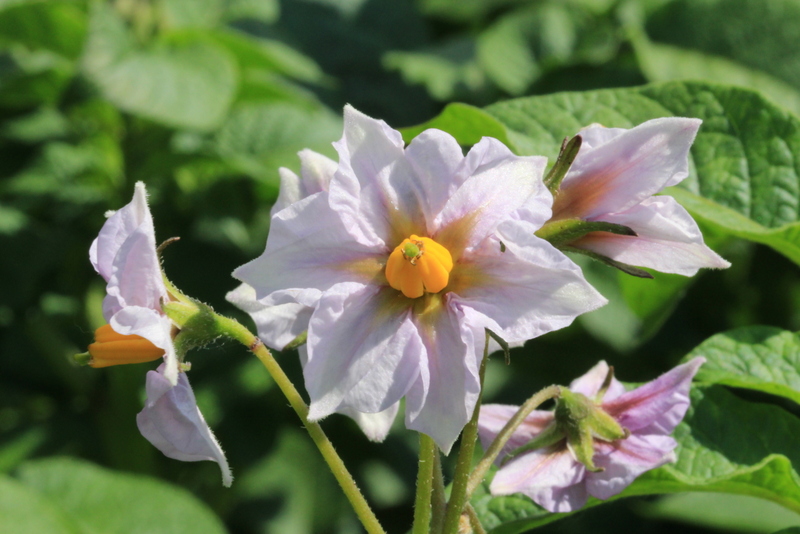Common Scab
Every year as harvest approaches there is excitement about getting the crop out of the ground. This is where all the hard work of raising a crop pays off. However, sometimes when the potato crop is lifted, there are unwanted ugly, scabby lesions—blemishes that spoil the appearance of the tuber and make them undesirable to consumers or difficult to process (Figure 1). This all too common problem is generally referred to as common scab. I get multiple calls each year about common scab and what can be done to control this disease. For this article, I wanted to summarize the biology of common scab and discuss what research has found to reduce common scab on potatoes. As we all start thinking about the 2018 crop, I hope this article will help us all understand common scab better.
Common scab comes from a soil-borne bacteria Streptomyces scabies or Streptomyces species that seem to be found in most soils. There are hundreds of bacterial species in the Streptomyces genus. This could explain why a potato cultivar may not be affected by common scab in one area, but have severe scab when planted in another geography. This wide spread disease expresses itself as raised, superficial and/or pitted lesions on the tuber (Figure 1 and 2). It can be difficult to visually determine the difference between common scab and powdery scab. A laboratory analysis is always a good idea to get the correct diagnosis. The NDSU Plant Diagnostic laboratory can test for scab types for a nominal fee.
The bacterium from Streptomyces species is spread by spores on seed, in the soil, in soil water and can hitch a ride on nematodes or insects. The spores enter the tubers through wounds and lenticels. Young lenticels are thought to provide entry to Streptomyces species. Once in the plant, Streptomyces scabies produces a phytotoxin called thaxtomin that breaks down cell walls and penetrates rapidly growing cells. As the potato plant cells die, they produce cork cells that push outward and form a scab lesion. As these cork cells continue to develop, the lesions grow larger. The type of scab (raised, superficial or pitted) varies based on the potato cultivar, environment and soil microbial community.
Tubers are most susceptible to infection of Streptomyces species during the first three to four weeks after tuber initiation, when compared to six to eight weeks after tuber initiation. Early infection can lead to deeper scab lesions on the tuber. However, there is less information available about susceptibility of tubers to the infection and development of common scab during late season tuber bulking.
There are a variety of means that research has shown to reduce common scab. However, few studies have shown effective and consistent control of common scab over many locations and years. Cultural and chemical practices are the current options.
Cultural practices
Ideal conditions for common scab infection are low soil moisture (less than 65-70% soil moisture) during tuber initiation, soil pH between 5.2 and 8.0 and daytime temperatures above 70 F, so increasing soil moisture to 80-85% during tuber initiation until tubers are 1 to 1.5 inches in size is reported to reduce common scab incidence. Utilizing a disease suppressive rotation with green manures, such as buckwheat, canola, oat, rye or millet can inhibit Streptomyces scabies. Animal manure has been reported to increase and decrease common scab. It may increase common scab when soil pH increases. Current research by Dr. Linda Kinkel in Minnesota has found local soil microbial populations have reduced common scab. Planting scab-resistant potatoes can be one of the best options, if the cultivar fits the potato operation. Breeding programs have focused on developing cultivars that are resistant to common scab and continue to evaluates clones for their resistance to common scab.
Chemical practices
Chemical management for common scab would likely include a good seed treatment to help maintain good plant health. A recent study reported that fludioxonil (Maxium) reduced common scab by 58% and a biopesticide containing Bacillus subtilis reduced common scab by 56%. Common scab has been suppressed by pentachloronitrobenzene (Blocker) as an in-furrow soil treatment. Chloropicrin (Strike) is a soil fumigant that provides control of a number of soil borne diseases and has been reported to work well to reduce common scab.
Common scab continues to be a problem for potato growers. This seed and soil borne disease can be managed somewhat through cultural and chemical practices, but there are no known methods that provide complete and consistent control. Researchers are continuing to study this disease and look for best management practices to control common scab. It is going to take an ongoing effort of research, breeding and better management practices to decrease common scab severity.





